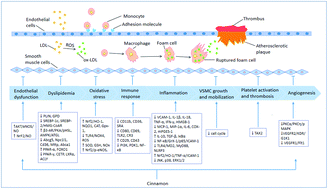Beneficial effects of cinnamon and its extracts in the management of cardiovascular diseases and diabetes†
Abstract
Cardiovascular diseases (CVDs) and diabetes are the leading causes of death worldwide, which underlines the urgent necessity to develop new pharmacotherapies. Cinnamon has been an eminent component of spice and traditional Chinese medicine for thousands of years. Numerous lines of findings have elucidated that cinnamon has beneficial effects against CVDs in various ways, including endothelium protection, regulation of immune response, lowering blood lipids, antioxidative properties, anti-inflammatory properties, suppression of vascular smooth muscle cell (VSMC) growth and mobilization, repression of platelet activity and thrombosis and inhibition of angiogenesis. Furthermore, emerging evidence has established that cinnamon improves diabetes, a crucial risk factor for CVDs, by enhancing insulin sensitivity and insulin secretion; regulating the enzyme activity involved in glucose; regulating glucose metabolism in the liver, adipose tissue and muscle; ameliorating oxidative stress and inflammation to protect islet cells; and improving diabetes complications. In this review, we summarized the mechanisms by which cinnamon regulates CVDs and diabetes in order to provide a theoretical basis for the further clinical application of cinnamon.



 Please wait while we load your content...
Please wait while we load your content...